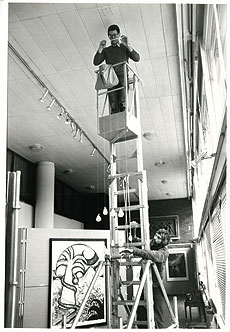Julian Freeman, curator and art historian
As the Polytechnic’s Exhibition Officer from October 1978 until December 1989, Julian introduced into the gallery’s annual programmes sporadic exhibitions that offered new perspectives to key themes in British art from the 1880s to the (then) present.

Julian Freeman curating in the Brighton Polytechnic Gallery
Over 600 exhibitions in different formats were presented by the exhibition unit under Julian’s stewardship. At its peak this work was highly creative, involving the generation of solo or mixed contemporary exhibitions in different media, often resulting from first class in-house collaborations, to exhibitions of broader art and design historical interest, including Arts Council tours.
By the mid-1980s the gallery was touring major loan exhibitions to important national and provincial venues, supported by fresh research and ideas in different areas of interest. Julian’s 1980 reassessment of Frank Brangwyn was unsurpassed until 2007, but other noteworthy shows remain unique, including a survey of mature works by Slade School students (1979), the art of the First World War (1982), and Landscapes from a High Latitude (1989-90), the first art historical survey of Icelandic landscape painting in the UK.
From 1992 until 2000 Julian returned to the university as a visiting lecturer and tutor and contributed to successive seasonal optional courses. Many of these examined important dormant but unfashionable themes in British art and culture, marked during earlier exhibition research, and ripe for review.
Julian Freeman worked at Sussex Downs College, Eastbourne in the early 2000s and wrote as a critic and reviewer, including his book British art: a walk round the rusty pier (Southbank 2006), which was commissioned to be divisive and which did the job handsomely. In 1998 Julian began a (now) long-standing association with The Art Book, a Blackwells’ quarterly review, and, in the same year, Simon & Schuster published Art: a crash course, a provocative ‘how-to-do-it’, which proved a worldwide success. In 2000, with his Brighton colleague Paul Clark, he co-wrote Design, the critically acclaimed, tenth and last in the Crash Course series.
